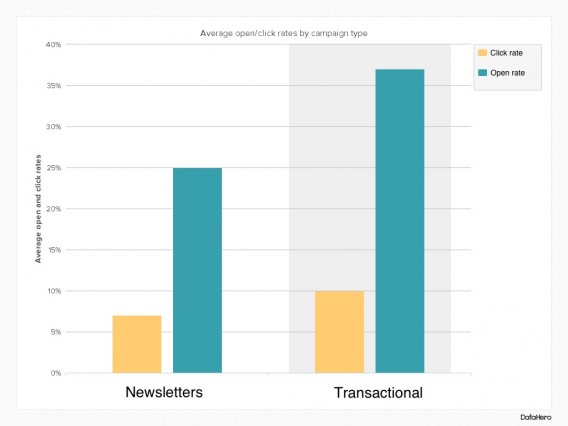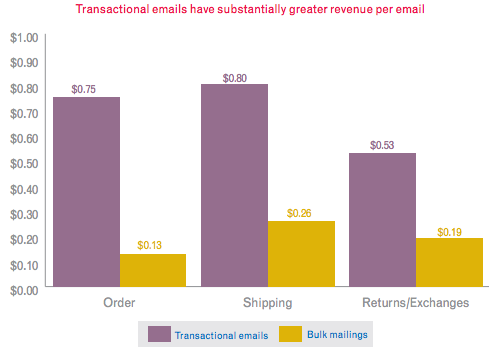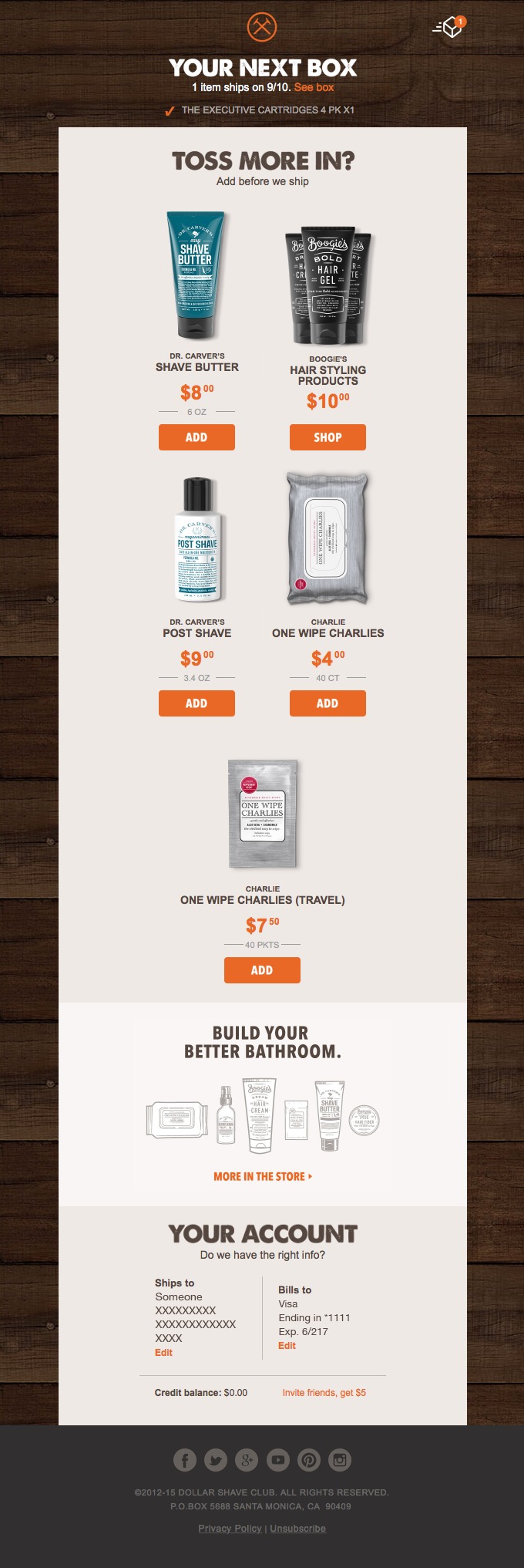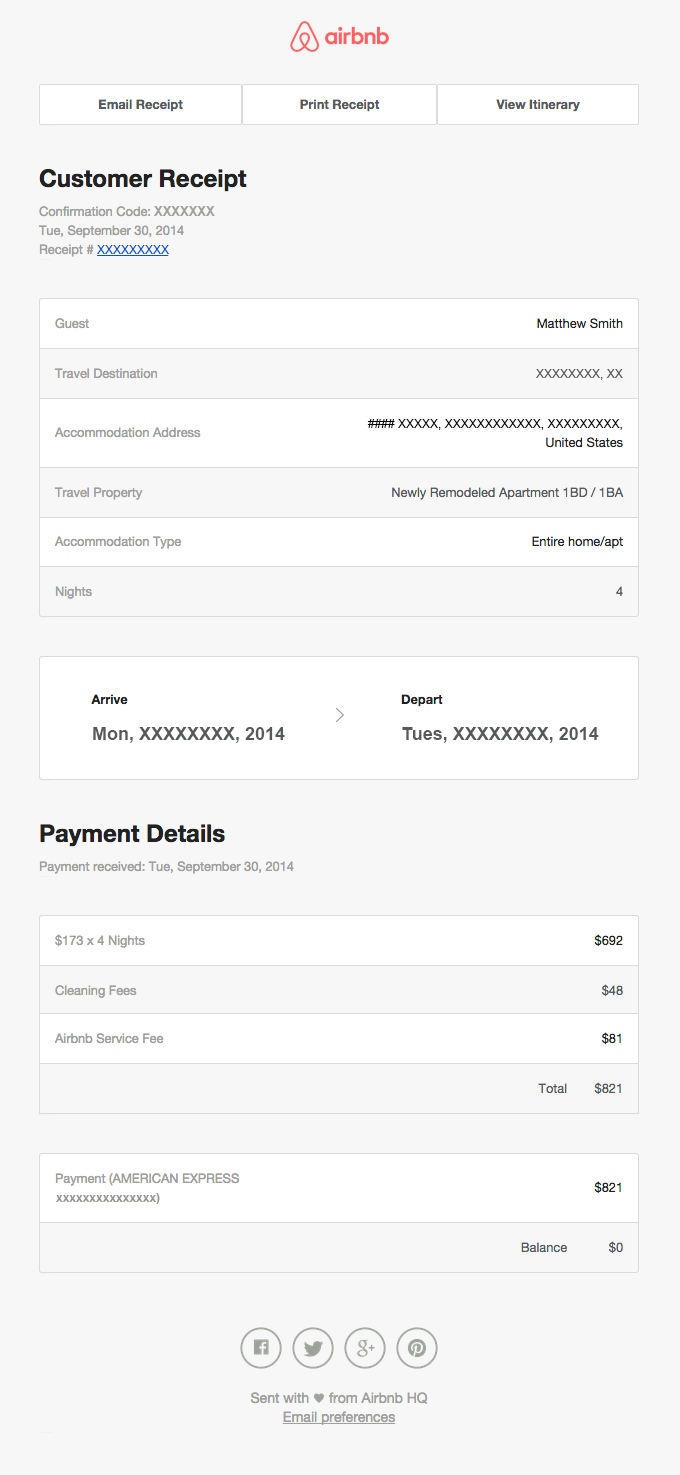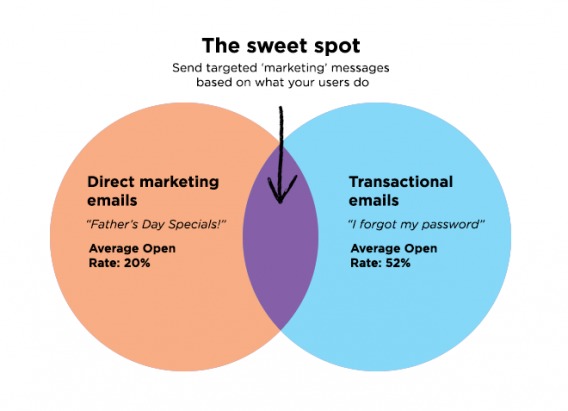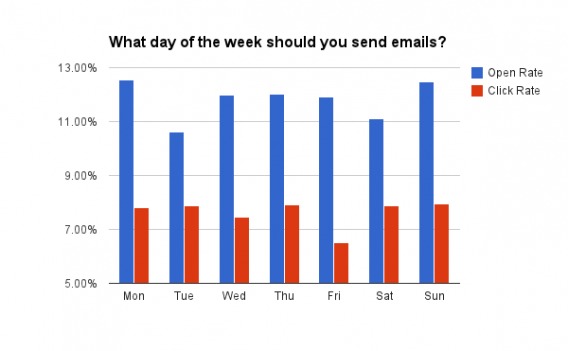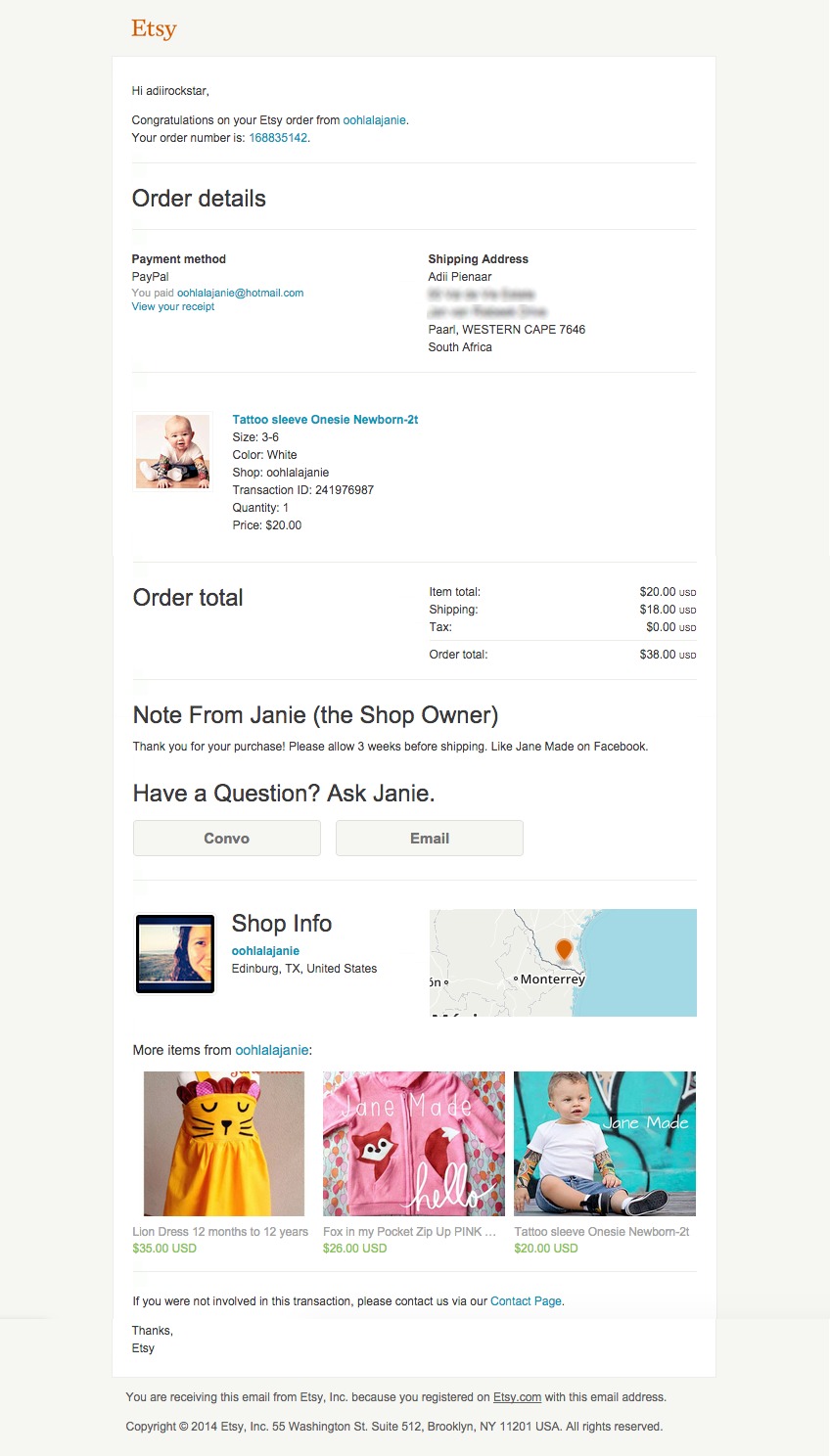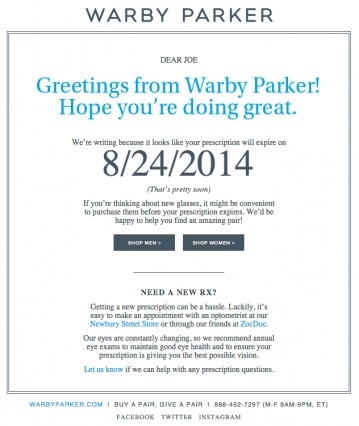Posted by: CXL
Posted on: 7/20/2019
As an ecommerce site, you likely send emails regularly. Black Friday emails, Valentine’s Day emails, BOGO emails, confirmation emails, thank you emails, reminder emails…the list is endless.
Are you getting real results or simply opens and clicks? Are you promoting the right products to the right people at the right time?
Generating revenue via email marketing requires strategy. It’s not about batching and blasting or promoting as many products as you can cram into one email.
Once you perfect your ecommerce email marketing strategy, conversions will soar. Unfortunately, it’s a little more complex than sending emails at 9:05 a.m. Eastern on Tuesday.
How important is email marketing for ecommerce?
Email has died, come back, evolved, died, and come back again. So what’s the truth about the state of email marketing in ecommerce?
A few years ago, Custora declared that email accounts for more than 7% of all ecommerce user acquisitions, making it the second-most effective acquisition channel (behind search). They also found that customer lifetime value (CLV) of email users is an impressive 12% above average.
In fact, 33% of consumers report that email is the biggest influence on their online spending. There’s really no denying it: Email marketing still plays a vital role in generating eCommerce revenue.
Promotional vs. transactional emails
There are two primary types of emails that you should be concerned with in ecommerce: promotional (direct marketing) and transactional. Does one work better than the other? Not necessarily. Both have benefits and drawbacks.
As usual, the best way to discover which is best is to test them with your audience. Regardless, you’ll still want to use both. What really matters is continuously improving the performance of promotional and transactional emails.
1. Promotional emails
Promotional emails are the standard self-serving, overtly promotional emails: 10% off discounts, $25 in free credits, limited-time-only product offerings, free shipping for purchases over $100, etc.
Good example: J.Crew
Take a look at this J.Crew email…
This was sent during the summer months, which explains the hot dog. The email clearly states the promotion (50% off) and makes it easy to navigate products (“WOMEN”, “MEN”, “SHOP SHORTS”).
These product category prompts help deliver a more customized shopping experience (i.e. a 34-year-old man shopping for himself won’t click through to find dresses.
Bad example: Saxx
Compare that to this Saxx email…
Can you spot a key difference? Note the calls to action. They’re all a muted grey and equal on the visual hierarchy. There’s nothing more appealing about “SHOP” than, say, “STORY.”
Plus, the call to action isn’t specific, which is not conducive to a personalized shopping experience. Will you be shopping for boxers? Briefs? Trunks?
2. Transactional emails
Transactional emails are based on visitor/customer behavior. They’re “if this, then that” emails. For example, if a visitor adds something to a cart but doesn’t buy, send them an email. Or, if a customer hasn’t made a purchase in a month or so, send them an email.
After analyzing 100 million emails, Vero found that transactional emails perform extremely well in terms of open rate and click rate. Take a look at how transactional emails stack up against a traditional newsletter-style email:
Experian took an even closer look, focusing on revenue. They found that, compared to standard bulk mailings, the average revenue per transactional email is 2–5x greater in all industries. In some cases, it’s 6x times greater than the industry-wide average of $0.13.
Here’s the data, sorted by the type of transactional email…
Whenever a transaction takes place, an email is triggered. These high-value ecommerce emails are often overlooked as an opportunity to increase revenue.
Good example: Dollar Shave Club
Here’s an email from Dollar Shave Club to someone whose monthly package is about to be shipped:
Instead of sending a plain, traditional reminder that the monthly box is about to ship, Dollar Shave Club uses this transactional email to tastefully squeeze more money from customers. With the click of a button, more items are added to your box—and more (recurring) revenue is generated.
Bad example: Airbnb
Now, here’s a transactional email from Airbnb:
Plain and traditional. Is any vital information missing? No, all of the important information is there. However, the opportunity to up-sell and cross-sell has been lost completely.
The final verdict on ecommerce email types
According to Vero, the “sweet spot” for ecommerce email types balances both promotional and transactional emails:
What really matters is that your emails are tailored to the people receiving them:
- Don’t send a 34-year-old man an email about your dress sale unless you know he purchases them regularly for a sister or wife.
- Don’t send someone who frequently opts for more affordable options an email about your luxury products.
That brings us to the next topic.
Personalization and segmentation in ecommerce email marketing
Dave Holland from Liveclicker has this to say about personalization:

Dave Holland, Liveclicker:
“Every marketer knows that personalized email messages convert better than ‘batch and blast’ messages. Unfortunately, most ecommerce businesses lack access to the rich store of data that’s required to deliver personalization at scale.
To solve for this, marketers should seek to capitalize on each recipient’s real-time personal context: geolocation, time, device, weather, etc. All of this can be done at the moment a recipient opens his email, thereby enabling 1:1 personalization to everyone in the database.” (via SmartInsights)
With so much information about your visitors and customers, it doesn’t make sense to send everyone the same email with the same call to action.
Here are just a few of the ways you can segment your emails:
- Products purchased in the past;
- Products browsed in the past;
- Typical price range;
- Typical product category;
- Geographic location;
- Weather conditions;
- Age group;
- Average order size;
- Last order data;
- Cart contents;
- Stage of the buying process.
Of course, the list goes on and on. Segment your audience using real-world data to deliver a personalized email and increase conversions. How? Well, some email service providers make it easier by building the capability in:
Chris Hexton from Vero explains how they do it…

Chris Hexton, Vero:
“One of the key things in Vero is trigger-based messaging, which adds a lot of context and personalization out of the box. If user did X, send them Y three days later if they haven’t done A, B, and C.
Let’s say you were sending someone an email when they viewed a product but hadn’t bought that product two days later. You could actually insert a picture of that product and all that good stuff, which makes it really, really specific for that individual. If you look at companies like Amazon and Airbnb, they do a really great job at this sort of stuff.” (via Marketing Optimization Podcast)
How to improve the open rate of your ecommerce emails
You can have a high click rate but generate very little revenue. However, we can all agree that improving your open rate consistently is a valid goal. If you want to generate revenue, you have to deliver emails successfully and make them appealing enough to open.
A common misconception is that there’s a “best” day of the week to send emails. Vero busted that myth after analyzing 100 million emails:
Similarly, there is no universally best time of day or best time of year or best subject line. It all comes down to your audience and your data. Experiment with different dates, times, subject lines, etc., to find out what works for you.
Earlier this year, I wrote an in-depth article on how to improve your open rate by combating image blocking, sending plain-text versions of your email, avoiding spam filters, etc.
Why context is vital to email opens
The closest you can come to a universal rule is that your email must have context. Without it, internal spam filters go off, and your email gets ignored.
To show context, simply answer this question as quickly as possible: Why am I receiving this email? As Jimmy Daly, formerly of Vero, explains:

Jimmy Daly, Vero:
“Context is king when it comes to email marketing. Your customers should intuitively understand why they are getting your emails. Yes, they subscribed, but what behavior triggered the message? Did it arrive at that right time in their buying process? And what, exactly, should they do next?” (via Vero)
Take a look at this example from Mark Macdonald at Shopify, who received an email from Whipping Post:
Context is quickly and clearly established. If your audience isn’t expecting to hear from you, open rates will suffer. That’s why transactional emails have such a high open rate—they’re expected, and the context is crystal clear.
The next-best solution is to explain yourself as quickly as possible. The longer it’s been since the last point of interaction (e.g., a sale, an email), the more important context becomes. Tell them why you’re emailing and remind them why they engaged with you in the first place.
Two of the best ways to provide context are to use segments and perfect your preview pane.
1. Segments
In Experian’s case study on Howard’s Storage World, they helped the company sort their loyalty program members into five segments based on activity. Then, the segments were sent a personalized promotion designed to re-engage them and encourage sales.
For example, “super members” were sent a $20 voucher. The result? Some 34% of the vouchers were redeemed, resulting in a $105,000 increase in revenue. Average spend was 16% higher than non-members.
Members who hadn’t shopped for over a year received a similar email. The result? Over 1,500 vouchers were redeemed, resulting in a $108,000 increase in revenue. The average spend was 37% higher than non-members.
Segmenting your audience helps you clarify context and communicate it more effectively. Instead of receiving a promotional email because “it’s spring,” they’re receiving a promotional email because they’re a valued customer or they haven’t made a purchase in 12 months.
2. Preview pane
Don’t wait until the email has been opened to provide context and explain why someone’s receiving your email. According to Convince and Convert, 84% of people 18–34 use an email preview pane. It’s your responsibility to provide context before the email is opened.
There are three ways to do it:
- From Name. Who are you? How do I know you? For example, “Shanelle Mullin”, “CXL,” or “Shanelle from CXL.”
- Subject Line. Be clear about the “what,” but leave a hint of mystery to intrigue your recipients.
- Preview Copy. Provide context here. Why are they receiving this email?
4 Types of ecommerce emails
Next, you have to decide what types of emails you’ll send. Hexton explains it best:

Chris Hexton, Vero:
“Don’t get in over your head. Start simple. Start by looking at your funnel (from the place where someone first hears about you to the place where they become a customer). Look at the place where you’ve got the biggest drop-off.
Start simple by focusing on where you can get the most gains. Map out your 5–6 key journey points and then focus on the places where you’ve got the lowest conversion rate from one point to the next.”(via Marketing Optimization Podcast)
Email can go a long way wherever you have large drop-offs. Of course, every funnel and business model is different, so it’s impossible to name a specific email (or two or three) that everyone should focus on. However, there are a few that are typically high-value starting points.
Note: Measure as close to the money as possible. Don’t focus on where you have the lowest open rates or click rates. Focus on where people are falling out of your funnel—where you’re leaking money.
1. Abandoned cart emails
If a visitor adds an item or two to their cart and leaves, you have a major opportunity. The intent is strong, right? That’s like going grocery shopping, collecting a week’s worth of food, and then leaving your cart on the floor and walking out.
Instead of hoping that visitors come back and complete their purchase later, take action. You can send them an email to remind them the items are there; ask if they have any questions or need help comparing their options; or even suggest similar items they might be interested in.
Example: BustedTees
When you add something to your cart at BustedTees and then return to the site, you’ll see a pop-up like this:
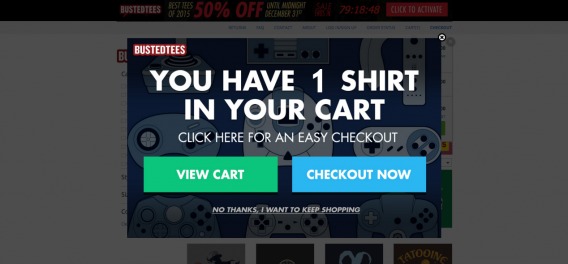
Notice the attention management here. “VIEW CART” and “CHECKOUT NOW” command so much attention that the concept of continuing to shop (“NO THANKS, I WANT TO KEEP SHOPPING”) is almost completely lost.
You’ll also receive an email like this approximately 30 minutes after abandoning your cart:
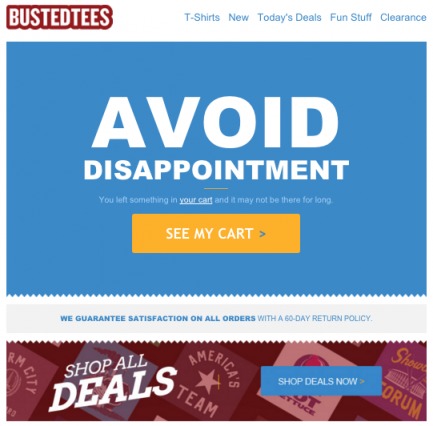
The primary ask is that you visit your cart and checkout. Since people who abandon their cart are likely on the fence, BustedTees highlights their return policy to put minds at ease. They also highlight deals for anyone who may have left to compare prices.
Three to four hours after the first email, you’ll receive a second one:

An offer of 20% off to complete a purchase you already started? I don’t have data from BustedTees, but I’m willing to bet this email sequence is quite effective.
2. Discount and sale emails
This is your traditional promotional email. How do you get more people to buy? You offer them a discount or put a popular product on sale. Seems simple, right?
It’s Valentine’s Day? Send an email offering a discount on jewelry, flowers, and chocolate. It’s Black Friday? Send an email announcing sales on your top products.
Unfortunately, it’s not quite that easy. Instead of sending batch emails, use segments. Does someone’s buying behavior indicate they’re single? Maybe skip that Valentine’s Day email.
Using segments, you can find out which holidays and celebrations are important to your audience. If someone hasn’t redeemed a Halloween coupon code in two years, stop sending them Halloween coupon codes.
Also, test whether your audience responds to 10% off–style discounts or $25 off–style coupons or “free shipping” offers. You can then segment your recipients. Don’t bother sending people who prefer $25-off coupons a 10%-off discount.
These minor adjustments can go a long way in terms of revenue.
Example: StickerYou
Take a look at this StickerYou email:
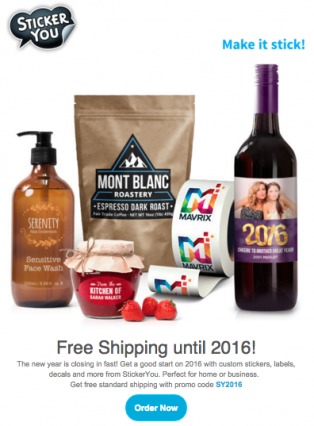
You immediately know you’re receiving the email because the new year is approaching. The call to action is simple, straightforward, and high contrast. The offer is uncomplicated and tempting.
However, let’s say that free shipping is a $10 value. There are people who would respond better to a $10 coupon or a 5%-off discount. The value might be the same, but the way the value is presented can have a big impact.
Also, StickerYou could have used a more descriptive image to reinforce the seasonal theme. The bottle of wine is perfect, but the other items shown have nothing to do with the new year, which threatens the context.
3. Confirmation emails
Confirmation emails are a type of transactional email. Once an order has been placed, order confirmation emails and shipping confirmation emails are sent. Often, engineers and developers have control of these emails. They’re usually plain text and functional (like the Airbnb example above).
However, as Litmus points out, order confirmation emails can actually be quite lucrative:
There are three core confirmation emails you can optimize:
- The initial receipt email.
- The “your order has shipped” email.
- The “thank you for choosing us” email.
While these emails must be primarily transactional (both for CAN-SPAM and integrity/branding reasons), they can be used to promote products.
Example: Etsy
Adii Pienaar, founder of Receiptful, which partnered with Litmus to analyze over 100,000 receipt emails, shared this example…
Etsy tastefully suggests other items from the shop where you purchased. Since you just purchased a product crafted by Janie, it makes sense that you might be interested in her other products.
The email still feels functional and transactional. Though it has the ability to generate revenue, it doesn’t feel like a promotional email masquerading as a transactional email. It’s important to find that balance before sending.
4. Recommendation and reminder emails
After the initial purchase, it’s your responsibility to keep customers coming back for more. One way to do that is to act as their personal shopper or concierge by offering recommendations and reminders.
There are four types of recommendations and reminders you can experiment with to re-engage previous customers:
- Replenishment emails. Is a product or subscription about to expire? Remind them that it’s time to stock up.
- Email recommendations based on browsing and purchase history. Have they been viewing a lot of t-shirts lately? Recommend some of the top t-shirts or t-shirts that similar customers similar have purchased.
- Gift suggestion emails. What gifts would go over well on Mother’s Day? Christmas? What about an upcoming birthday? (There’s always an upcoming birthday.) Gift giving is hard, so take the work out of it.
- Review request emails. What did they think of the last product they purchased? Remind them how much they loved it by asking them to review it and suggesting similar/complementary products.
Colin Nederkoorn from Customer.io shared an example of a gift suggestion email:

Colin Nederkoorn, Customer.io:
“One of our customers’ products is ideal for gifts, so people either buy it for themselves or they buy it as a gift, and they used Customer.io to target the people who had purchased it as a gift, and they offered them,”Why don’t you buy this for yourself now?”
They also did the inverse of that. For people who had bought it for themselves, they said, “Why don’t you go and buy this as a gift?” They got a great conversion from that.
It was around the holidays last year, and a bunch of people ended up buying who hadn’t visited the site in three months, four months, but they ended up buying that product as a gift for someone or for themselves.” (via McMethod)
Example: Warby Parker
Take a look at this example from Warby Parker:
It’s not Warby Parker’s job to keep track of when their customers need new prescriptions. However, going the extra mile and reminding their customers of their upcoming need, they position themselves extremely well.
Joe might have purchased from Warby Parker 6–12 months ago. It’s easy to forget a retailer in that amount of time, right? Well, now Warby Parker has gained top-of-mind status and re-engaged Joe without much effort.
Of course, Warby Parker could have offered suggestions based on Joe’s last purchase. And since they know Joe purchased men’s frames last time, they could have removed the “SHOP WOMEN” button.
Conclusion
We need to move away from batch-and-blast ecommerce emails that end up in spam folders. Instead, follow your data and use strategic emails to plug the holes money is leaking from.
- Go through your funnel to identify drop-off points. Start by optimizing your emails at these stages.
- Segment your audience based on their demographic and behavior.
- Ensure every email you send quickly answers the question: Why am I receiving this email?
- Set up an abandoned cart email to remind visitors of the items in their cart or to suggest complementary products. This will encourage them to return and complete the checkout process.
- Use your segments to send meaningful, relevant seasonal emails instead of batch seasonal emails. Run tests to ensure you’re presenting discounts in the way recipients respond to best. (It’s different for everyone).
- Take control of your confirmation emails and use them to promote relevant products instead of keeping them exclusively functional.
- Re-engage previous customers by reminding them of products that need to be replenished or recommending products based on browsing/purchase history.
The post Ecommerce Email Marketing: How to Increase Conversions appeared first on CXL.





